可可挥发性化合物影响香气,但不影响味道
IF 0.7
4区 农林科学
Q3 AGRONOMY
引用次数: 1
摘要
风味是决定可可豆质量的最重要指标之一,尤其是风味优良的可可豆。豆类中的挥发性化合物影响风味产生的机理。因此,本研究旨在确定芳香族和非芳香族可可基团中的挥发性化合物作为FFCs指标之一。这项研究是在印度尼西亚东爪哇省詹伯的印度尼西亚咖啡和可可研究所进行的。此外,所使用的遗传物质由六种芳香族可可基因型组成,如DR 2、ICCRI 03、ICCRI 07、ICCRI 09、MCC 02和TSH 858,以及四种非芳香族基因型,如苏拉威西1、苏拉威西2、KW 516和KEE 2。采用完全随机区组设计(RCBD),重复三次。在东爪哇詹伯理工学院食品与科学实验室对每个基因型的发酵豆样品进行挥发性化合物分析,并由ICCRI的三名认证小组成员进行感官测试。数据采用IRRI的STAR 2.0.1软件进行正交对比分析。而Microsoft Excel 2019和R Studio用于相关性分析和热图。结果表明,可可豆中醛类、酸类、酯类、吡咯类和吡嗪类的芳香族基团高于非芳香族基团。丙氨酸和萜类化合物仅在克隆DR 2和ICCRI 03中发现,而醇类和酚类化合物在非芳香族中占主导地位。基因型根据风味和挥发性化合物分为六组。ICCRI09具有强烈的酸度和新鲜的水果、辛辣和甜味以及含有醛类的香气。此外,ICCRI 03、MCC 02和TSH 858豆的酸度和香气比ICCRI 09弱,并且含有萜类化合物。ICCRI07具有坚果和木质香气,主要由呋喃和吡嗪化合物组成。而苏拉威西1号有腐烂的香气和生物碱。KW 516、KEE2和苏拉威西2号基因型具有涩味、脏/尘和发霉的香气,并含有酒精和苯酚。关键词:芳香族;风味非芳香族;可可;挥发性化合物本文章由计算机程序翻译,如有差异,请以英文原文为准。
Cocoa volatile compounds affect aroma but not taste
Flavor is one of the most essential indicators for determining the quality of cocoa beans, especially fine flavor cocoa. The volatile compound in the beans affect the mechanism the flavor emergence. Therefore, this study aimed to identify the volatile compound in the aromatic and non-aromatic cocoa groups as one of FFCs indicator. It was conducted at the Indonesian Coffee and Cocoa Research Institute, Jember, East Java, Indonesia. Furthermore, the genetic material used consisted of six aromatic cocoa genotypes, such as DR 2, ICCRI 03, ICCRI 07, ICCRI 09, MCC 02, and TSH 858 as well as four non-aromatic genotypes such as Sulawesi1, Sulawesi 2, KW 516, and KEE 2. A completely randomized block design (RCBD) was used with three repetitions. The fermented bean samples of each genotype were analyzed of volatile compound at the Food and Science Laboratory, Jember Polytechnic, East Java and sensory test was conducted by three certified panelists from ICCRI. Data were analyzed by orthogonal contrast analysis with IRRI's STAR 2.0.1 software. While the Microsoft Excel 2019 and R Studio were used for correlation analysis and heatmaps. The results showed aldehydes, acids, esters, pyrroles, and pyrazines of aromatic cocoa bean group higher than the non-aromatic. The alanine and terpenoid compounds was only found in clones DR 2 and ICCRI 03, while the alcohol and phenol compounds dominated in the non-aromatic group. Genotypes were grouped into six groups, based on flavor and volatile compound. ICCRI 09 characterized by strong acidity with a fresh fruit, spicy and sweet aroma as well as containsed aldehydes. Furthermore, ICCRI 03, MCC 02, and TSH 858 bean had weaker acidity and aroma than ICCRI 09 and contain terpenoids. ICCRI 07 had a nutty and woody aroma and was dominated by furan and pyrazine compounds. While Sulawesi 1 had a putrid aroma and alkaloids. The genotype groups of KW 516, KEE2, and Sulawesi 2 had astringent taste, dirty/dusty and moldy aroma as well as contained alcohol and phenol.
Keywords: Aromatic; Flavor; Non-aromatic; Theobroma cacao L; Volatile compounds
求助全文
通过发布文献求助,成功后即可免费获取论文全文。
去求助
来源期刊

Emirates Journal of Food and Agriculture
AGRONOMYFOOD SCIENCE & TECHNOLOGY&nb-FOOD SCIENCE & TECHNOLOGY
CiteScore
1.80
自引率
0.00%
发文量
18
期刊介绍:
The "Emirates Journal of Food and Agriculture [EJFA]" is a unique, peer-reviewed Journal of Food and Agriculture publishing basic and applied research articles in the field of agricultural and food sciences by the College of Food and Agriculture, United Arab Emirates University, United Arab Emirates.
 求助内容:
求助内容: 应助结果提醒方式:
应助结果提醒方式:


